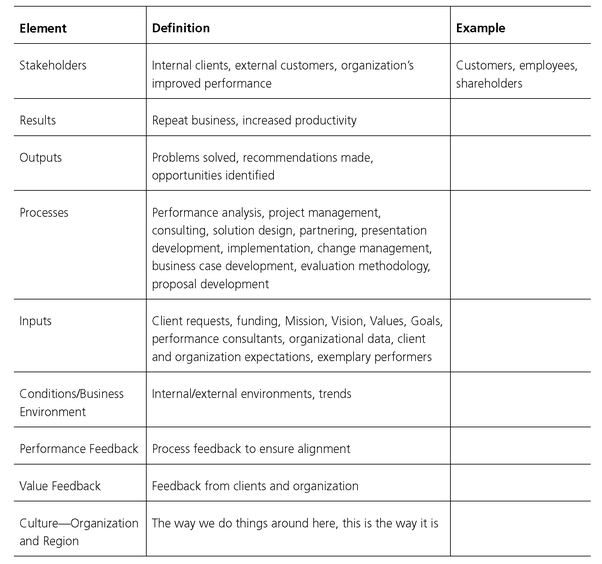WORK/PROCESS
Are you currently managing a training department, organization development team, or other performance improvement-focused group? Or do you aspire to head such a group? If your answer is yes, then we have a modest proposal for you. Someone has to manage the performance improvement efforts in an organization, so why not use what you’ve learned from this book to construct a performance improvement department to lead the effort?
Performance Improvement Department
We’ve seen any number of organizations in which several different groups are focused on performance improvement, each with its special technology, working hard to make a difference. Think of human resources, learning and development, information technology, business process improvement, quality assurance, and others. Since these groups are all aiming for the same end result, why not pull them together as one skilled team in the performance improvement department? Imagine the potential value to the organization that a group of performance improvement specialists with skills in Six-Sigma., lean manufacturing, organization development, training, performance technology, human factors, and related disciplines could have.
Rather than attacking the same problems independently and from one perspective at a time, a combined team could identify the most appropriate techniques from among the many represented to improve performance in a cohesive way. Clients would be able to access the combined technologies for results:
• Human Performance Technologies—focused on people
• Process Performance Technologies—focused on process and procedure
• Organization Performance Technologies—focused on organization development
And of course, the newly established performance improvement department will require a manager.
Chief Performance Officer. A chief performance officer (CPO) could manage this new group, eliminating duplicate efforts, achieving economies of scale, and leveraging skills and influence to bring change across the enterprise. This manager would be able to integrate functions to gain support for performance improvement initiatives. Working both vertically, within functional lines, and horizontally across them, the CPO would have a unique and valuable line of sight (see Chapter 4: The Workplace: Organization Level, for more on line of sight) that could increase credibility for performance improvement and the results produced.
With the CPO’s leadership, much of the confusion each of the disciplines causes clients, with unique language, models, and approaches, could be streamlined into a focus on the total performance system of the organization. Integrating all the related disciplines under a CPO has great potential for client satisfaction.
Elements of the Performance Improvement Department. Do you recall the Total Performance System (TPS) first introduced In Chapter 2, The Worker: Individual/Team Level, as a tool performance consultants can use to analyze an organization? You can also use the TPS to build an organization from the beginning or modify an existing one. While other tools are available, we suggest the TPS because it is familiar. Begin in the usual place, with the results you want to produce, and follow with the remaining RSVP principles, first introduced in Chapter 1, The Performance Technology Landscape. A quick review:
R—Focus on results: Initiate projects by specifying what the end result is to be.
S—Take a system viewpoint: Consider all aspects of the organization’s performance system.
V—Add Value: Produce results that make a difference.
P—Establish Partnerships: Work with clients and other specialists to share skills, knowledge, creativity, and successes.
RSVP becomes the four-legged foundation for the performance improvement department you are building. Now you are ready to use the TPS model to structure your PI department. Look at Table 8.1. The elements are the same as those for a TPS analysis except the “receivers” are now identified as “stakeholders.” The definitions have been adjusted to focus on the construction of a new department. Your task is to complete the Examples column with specifics for your organization. We filled one in to get you started.
TABLE 8.1. Total Performance System.
Source: ©2008 International Society for Performance Improvement. Used with permission.

With a TPS completed for your new PI department, you are on your way to establishing a team with tremendous potential in your organization.
..................Content has been hidden....................
You can't read the all page of ebook, please click here login for view all page.
